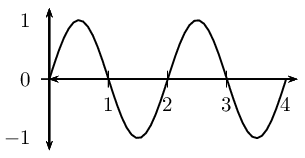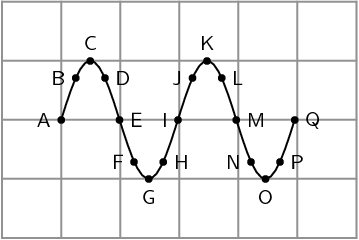When the particles of a medium move perpendicular to the direction of the wave motion, the wave is called a wave.
8.7 Speed of a transverse wave
|
Previous
8.6 Period and frequency
|
Next
Chapter summary
|
8.7 Speed of a transverse wave (ESACQ)
- Wave speed
-
Wave speed is the distance a wave travels per unit time.
Quantity: Wave speed (\(v\)) Unit name: metre per second Unit symbol: \(\text{m·s$^{-1}$}\)
The distance between two successive crests is \(\text{1}\) wavelength, \(λ\). Thus in a time of \(\text{1}\) period, the wave will travel \(\text{1}\) wavelength in distance. Thus the speed of the wave, \(v\), is:
\[v = \frac{\text{distance travelled}}{\text{time taken}} = \frac{\lambda}{T}\]However, \(f = \frac{1}{T}\). Therefore, we can also write:
\begin{align*} v & = \frac{\lambda}{T} \\ & = \lambda \cdot \frac{1}{T} \\ & = \lambda \cdot f \end{align*}We call this equation the wave equation. To summarise, we have that \(v = \lambda \cdot f\) where
-
\(v =\) speed in \(\text{m·s$^{-1}$}\)
-
\(\lambda =\) wavelength in \(\text{m}\)
-
\(f =\) frequency in \(\text{Hz}\)
Wave equation:
\[v = f \cdot \lambda\]or
\[v = \frac{\lambda}{T}\]Worked example 4: Speed of a transverse wave I
When a particular string is vibrated at a frequency of \(\text{10}\) \(\text{Hz}\), a transverse wave of wavelength \(\text{0,25}\) \(\text{m}\) is produced. Determine the speed of the wave as it travels along the string.
Determine what is given and what is required
-
frequency of wave: \(f = \text{10}\text{ Hz}\)
-
wavelength of wave: \(\lambda = \text{0,25}\text{ m}\)
We are required to calculate the speed of the wave as it travels along the string.
All quantities are in SI units.
Determine how to approach the problem
We know that the speed of a wave is:
\[v = f \cdot \lambda\]and we are given all the necessary quantities.
Substituting in the values
\begin{align*} v & = f \cdot \lambda \\ & = (\text{10}\text{ Hz})(\text{0,25}\text{ m}) \\ & = (\text{10}\text{ s$^{-1}$})(\text{0,25}\text{ m}) \\ & = \text{2,5}\text{ m·s$^{-1}$} \end{align*}Write the final answer
The wave travels at \(\text{2,5}\) \(\text{m·s$^{-1}$}\) along the string.
Worked example 5: Speed of a transverse wave II
A cork on the surface of a swimming pool bobs up and down once every second on some ripples. The ripples have a wavelength of \(\text{20}\) \(\text{cm}\). If the cork is \(\text{2}\) \(\text{m}\) from the edge of the pool, how long does it take a ripple passing the cork to reach the edge?
Determine what is given and what is required
We are given:
-
frequency of wave: \(f = \text{1}\text{ Hz}\)
-
wavelength of wave: \(\lambda = \text{20}\text{ cm}\)
-
distance of cork from edge of pool: \(D = \text{2}\text{ m}\)
We are required to determine the time it takes for a ripple to travel between the cork and the edge of the pool.
The wavelength is not in SI units and should be converted.
Determine how to approach the problem
The time taken for the ripple to reach the edge of the pool is obtained from:
\[t = \frac{D}{v} \qquad \left(\text{from } v = \frac{D}{t}\right)\]We know that
\[v = f \cdot \lambda\]Therefore,
\[t = \frac{D}{f \cdot \lambda}\]Convert wavelength to SI units
\[\text{20}\text{ cm} = \text{0,2}\text{ m}\]Solve the problem
\begin{align*} t & = \frac{D}{f \cdot \lambda} \\ & = \frac{\text{2}\text{ m}}{(\text{1}\text{ Hz})(\text{0,2}\text{ m})} \\ & = \frac{\text{2}\text{ m}}{(\text{1}\text{ s$^{-1}$})(\text{0,2}\text{ m})} \\ & = \text{10}\text{ s} \end{align*}Write the final answer
A ripple passing the leaf will take \(\text{10}\) \(\text{s}\) to reach the edge of the pool.
Waves
A transverse wave is moving downwards. In what direction do the particles in the medium move?
Consider the diagram below and answer the questions that follow:

-
the wavelength of the wave is shown by letter .
-
the amplitude of the wave is shown by letter .
Draw 2 wavelengths of the following transverse waves on the same graph paper. Label all important values.
-
Wave 1: Amplitude = \(\text{1}\) \(\text{cm}\), wavelength = \(\text{3}\) \(\text{cm}\)
-
Wave 2: Peak to trough distance (vertical) = \(\text{3}\) \(\text{cm}\), crest to crest distance (horizontal) = \(\text{5}\) \(\text{cm}\)
You are given the transverse wave below.

Draw the following:
-
A wave with twice the amplitude of the given wave.
-
A wave with half the amplitude of the given wave.
-
A wave travelling at the same speed with twice the frequency of the given wave.
-
A wave travelling at the same speed with half the frequency of the given wave.
-
A wave with twice the wavelength of the given wave.
-
A wave with half the wavelength of the given wave.
-
A wave travelling at the same speed with twice the period of the given wave.
-
A wave travelling at the same speed with half the period of the given wave.
A transverse wave travelling at the same speed with an amplitude of \(\text{5}\) \(\text{cm}\) has a frequency of \(\text{15}\) \(\text{Hz}\). The horizontal distance from a crest to the nearest trough is measured to be \(\text{2,5}\) \(\text{cm}\). Find the
-
period of the wave.
-
speed of the wave.
A fly flaps its wings back and forth 200 times each second. Calculate the period of a wing flap.
As the period of a wave increases, the frequency increases/decreases/does not change.
Calculate the frequency of rotation of the second hand on a clock.
Microwave ovens produce radiation with a frequency of \(\text{2 450}\) \(\text{MHz}\) (\(\text{1}\) \(\text{MHz}\) = \(\text{10}^{\text{6}}\) \(\text{Hz}\)) and a wavelength of \(\text{0,122}\) \(\text{m}\). What is the wave speed of the radiation?
Study the following diagram and answer the questions:

-
Identify two sets of points that are in phase.
-
Identify two sets of points that are out of phase.
-
Identify any two points that would indicate a wavelength.
Tom is fishing from a pier and notices that four wave crests pass by in \(\text{8}\) \(\text{s}\) and estimates the distance between two successive crests is \(\text{4}\) \(\text{m}\). The timing starts with the first crest and ends with the fourth. Calculate the speed of the wave.
|
Previous
8.6 Period and frequency
|
Table of Contents |
Next
Chapter summary
|
